I hate to call attention to it but forewarned is forearmed.

I hate to call attention to it but forewarned is forearmed.
Tucson Musicians, Dancers, and the El Casino Ballroom Join Together in Major Fundraising Effort for Daniel Buckley’s film The Mariachi Miracle
Click image to enlarge
https://www.youtube.com/watch?t=55&v=zZrx1F2zBBk
Contact: Daniel Buckley, 520-260-4176, dbtucson@gmail.com
Tucson, AZ– -From 2 pm to midnight, on Saturday, June 27, the El Casino Ballroom will rock when a showcase of Tucson mariachis, folklórico, norteño, Latin pop and Tejano greats join together in a major fundraising effort to help Daniel Buckley complete his film The Mariachi Miracle.
The Mariachi Miracle is a film/book project that traces the remarkable impact the youth mariachi and folklórico programs started in Tucson, AZ have had not only on the city of Tucson, but across the nation as well.
Daniel Buckley talks about The Mariachi Miracle on KGUN’s The Morning Blend
For the admission price of only $10, people can come down to the El Casino Ballroom at 427 E. 26th Street, South Tucson and enjoy a up to ten hours of Tucson music magic.
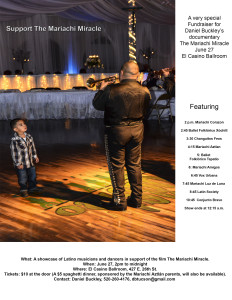 Among those performing will be Mariachi Luz de Luna, Vox Urbana, Tejano all-star band Latin Society, Conjunto Bravo, plus an all-star lineup of the youth mariachi and folklórico groups, including Mariachi Corazon, Ballet Folklórico Tapatio, Mariachi Los Changuitos Feos, Ballet Folklórico Xóchitl, Mariachi Aztlán de Pueblo High School and long time mariachi instructor David Membrila’s Mariachi Amigos.
Among those performing will be Mariachi Luz de Luna, Vox Urbana, Tejano all-star band Latin Society, Conjunto Bravo, plus an all-star lineup of the youth mariachi and folklórico groups, including Mariachi Corazon, Ballet Folklórico Tapatio, Mariachi Los Changuitos Feos, Ballet Folklórico Xóchitl, Mariachi Aztlán de Pueblo High School and long time mariachi instructor David Membrila’s Mariachi Amigos.
Here is the lineup:
For over 30 year as a music writer for the Tucson Citizen and as a documentary filmmaker, Daniel Buckley has been a strong advocate for the Latino community here in Tucson.
“I’m so grateful for the outpouring of support for this project,” Buckley said. “In order to deliver a top quality film– one that not only documents the importance of Tucson’s youth mariachi and folklórico programs, but that can also serve as a tool to advocate for the arts and cultural heritage in K-12 education and the growth of these youth programs across America– I estimate that we will need to raise $250,000 to complete the film. I am hopeful that we can get to that number.”
BREAKING NEWS: The Tucson International Mariachi Conference has issued a $2500 challenge grant for The Mariachi Miracle! We have to match the funds to receive it, but this is great news for the project. Contact Daniel Buckley at dbtucson@gmail.com or 520-260-4176 for details.
Raffles, silent auctions will take place throughout the night and merchandise will be available for sale. In anticipation that this event will be a very special Tucson night, Wavelab Studio’s Craig Shumacher will be recording the event, with plans to release a fundraising CD for the film. A GoFundMe crowd funding effort will be launched shortly, along with other fund raising activities.
###
Summary of Event
What: A fundraiser showcasing Latino musicians and dancers to support the making of the film The Mariachi Miracle.
When: Saturday, June 27, 2pm to midnight
Where: El Casino Ballroom, 427 E. 26th St.
Tickets: $10 at the door (A $5 spaghetti dinner, sponsored by the Mariachi Aztlán parents, will also be available).
Contact: Daniel Buckley, 520-260-4176, dbtucson@gmail.com
About The Mariachi Miracle
The Mariachi Miracle is a film/book project by Daniel Buckley that documents how treasured cultural practices can lead to social change. Specifically, it chronicles the remarkable impact the youth mariachi programs started in Tucson, AZ have had not only on the city of Tucson, but across the nation as well. Universally, the project champions the value of arts and cultural heritage in education.
The Mariachi Miracle is scheduled to premiere at the Fox Theatre, Tucson in April, 2016 as part of a special edition of the Tucson International Mariachi Conference, which will include a two day national summit on mariachi education in collaboration with The White House Initiative on Educational Excellence for Hispanics, The University of Arizona Fred Fox School of Music, The UA Center for Latin American Studies, The Arizona Historical Society, La Frontera and other organizations.
To date, Daniel Buckley has self-funded a large portion of the project, with other support for The Mariachi Miracle coming from the Tucson Pima Arts Council, The Southwestern Foundation, The Chann Foundation, Pima County Supervisors, The Pascua Yaqui Tribe, a 2012 Kickstarter campaign and others. Another $250,000 still needs to be raised to complete the project. La Frontera is the non-profit fiscal sponsor for the project.
For videos, links and more go to The Mariachi Miracle One Stop at http://www.danielbuckleyarts.com/2014/12/the-mariachi-miracle-one-stop/
http://www.danielbuckleyarts.com/2014/10/the-mariachi-miracle-in-brief/
https://www.youtube.com/watch?t=55&v=zZrx1F2zBBk – video
About Daniel Buckley
The project is brainchild of former Tucson Citizen newspaper music critic turned documentary maker, Daniel Buckley, who has covered the mariachi scene for over 30 years and was inducted into the Mariachi Hall of Fame in 2013. Buckley honed his filmmaking skills when he created and managed the media division for the Citizen. Buckley is also the 2014 Artist of the Year winner at the Arizona Governor’s Arts Awards. In 2009, Buckley started the Cine Plaza at the Fox, a documentary series that focused on Hispanic history and culture in Southern Arizona. The Mariachi Miracle is the sixth film and first book in that series and will be his first breakout to a national audience.
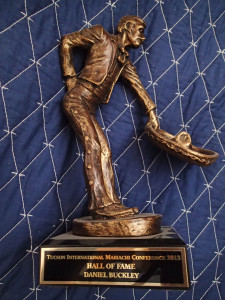 For Buckley’s biography go to: http://www.danielbuckleyarts.com/home/bios/daniel-buckley-documentary-maker/ –
For Buckley’s biography go to: http://www.danielbuckleyarts.com/home/bios/daniel-buckley-documentary-maker/ –
Click image to enlarge
How I created the image – Ancestors.
To the Tohono O’odham (desert people) tribe of Southern Arizona, the iconic saguaro cacti of the Sonoran Desert are ancestors. They revere them and will not collect their woody skeletons for firewood, as that would be an act of burning one’s ancestors.
The cacti resemble people in their general form, with outstretched arms protruding from their elongated bodies. But they are so much more.
The gray scale (black and white) image I created called “Ancestors” was originally shot in April, 2013 using a full-frame Nikon D800 camera and a 28-70mm lens. I shot to camera raw in color, and initially processed it as a color image. The photo was shot at Saguaro National Park West, just west of Tucson, Arizona.
I would return to that image in 2015 to create a new gray scale version. Often I revisit older images once I have developed other skills.
Working in camera raw affords so much flexibility when editing in Adobe Photoshop. The areas in shadow are easily brought out, and the general character of the image can be manipulated in many ways.
Most of the basic manipulation was done within camera raw, working to get the details and contrasts just right before starting the gray scale conversion, and making minor tweaks after as well.
When converting to gray scale, Photoshop allows one to manipulate the different colored light individually.
Although the original image was shot at approximately 3:30 p.m., I wanted to create the illusion that this was a moonlit image. The sky was vivid blue in the original, so I reduced the saturation of the blue channel to zero to create the illusion of a black sky. Reds, yellows, oranges and greens were likewise heightened or reduced to bring out specific features within the shot. And once the basic image was complete and it had been changed to a Photoshop image, I applied curves to heighten the contrast and exaggerate the glow around the perimeter of the saguaro and the outline of the ocotillo.
The final image has the kind of other worldly quality I set out after, amplifying the spiritual meaning of the living saguaros and the skeletons of those who came before, and lending a kind of metaphysical glow to the desert and horizon.
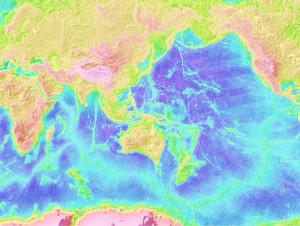 In planetary sciences, the term Remote Sensing refers to the use of imaging in a variety of spectra to detect details that might otherwise remain undetected. Remote sensing always involves gathering information without making physical contact with the subject.
In planetary sciences, the term Remote Sensing refers to the use of imaging in a variety of spectra to detect details that might otherwise remain undetected. Remote sensing always involves gathering information without making physical contact with the subject.
One might use color or black and white imagery, infrared or ultraviolet wavelengths, as well as radar and other means in order to glean information about a planet, celestial body or even the earth itself.
Recently I started a new musical series based on the wonders of space. In thinking of a title for the series I was brought back to the idea that our knowledge of such far flung locations comes largely through Remote Sensing techniques, and so I decided to go with that title.
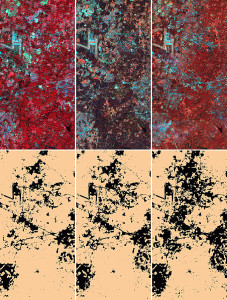 It was an area of particular interest to me as a geology student at the University of Arizona, and I felt honored to have studied remote sensing with a man who had been among the first to map Arizona from horseback in the 1930s, and who had gone on to become an expert in air and space born remote sensing techniques.
It was an area of particular interest to me as a geology student at the University of Arizona, and I felt honored to have studied remote sensing with a man who had been among the first to map Arizona from horseback in the 1930s, and who had gone on to become an expert in air and space born remote sensing techniques.
While my own interest in the topic had to do with its practical application in uncovering the secrets of the moon, Dr. Morrison taught me that it could uncover far more right here on earth, and that one could then go out and see what caused an anomaly when such things were encountered in the various forms of multispectral photography we were working with.
And so my Remote Sensing series draws on those experiences, on the sense of space and distance, on the wonder of being able to more fully imagine what is going on in the universe, and a bit on the technical capabilities needed to make such observations.
The audio work Nebula is an example from that emerging series. Scored for prepared piano and strings, it imagines the rumbling collisions and luminous glows of these gas cloud features far off in space.
It is my view of the universe around me, melding science and imagination.
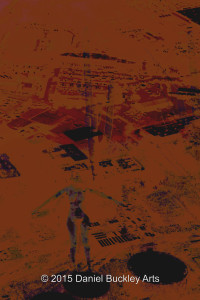 The concept of remote sensing is also finding its way into some of my art photography projects. I am using Photoshop to alter the color and contrast, superimpose multiple images and create something that looks more akin to images created through remote sensing than to those of the standard camera work by which these images originated.
The concept of remote sensing is also finding its way into some of my art photography projects. I am using Photoshop to alter the color and contrast, superimpose multiple images and create something that looks more akin to images created through remote sensing than to those of the standard camera work by which these images originated.
Again, my multiple artform work converges around similar concepts.
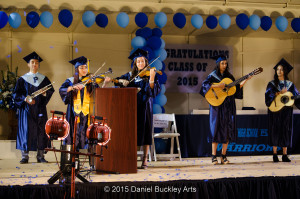 While working on The Mariachi Miracle I have seen a large number of the teachers and students of the mariachi community of Tucson in a very close and personal way over a long period of time. From these extended encounters I have come to view these young men and women as much for their personal character as for their musical and educational achievement. And I come away very impressed with what I see time and again.
While working on The Mariachi Miracle I have seen a large number of the teachers and students of the mariachi community of Tucson in a very close and personal way over a long period of time. From these extended encounters I have come to view these young men and women as much for their personal character as for their musical and educational achievement. And I come away very impressed with what I see time and again.
In under a week I have gone from watching a high school graduation at Pueblo High Magnet School to watching many of the members of that school’s mariachi program serving as teachers and assistants in an elementary school mariachi summer camp.
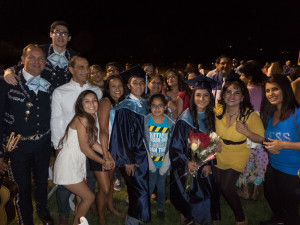 Graduation night is a special occasion at Pueblo, particularly for the members of Mariachi Aztlan, graduating senior or not. It’s a time of great emotion as the seniors head out into the real world. But it’s also the first night in Mariachi Aztlan for the incoming group of young players stepping in to replace them. Some of these new recruits have barely finished eighth grade, but their talent has won them a spot with one of the city’s finest performing groups.
Graduation night is a special occasion at Pueblo, particularly for the members of Mariachi Aztlan, graduating senior or not. It’s a time of great emotion as the seniors head out into the real world. But it’s also the first night in Mariachi Aztlan for the incoming group of young players stepping in to replace them. Some of these new recruits have barely finished eighth grade, but their talent has won them a spot with one of the city’s finest performing groups.
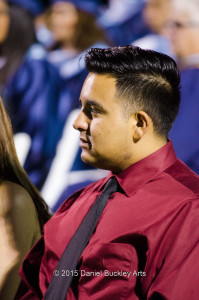 The main action of the night was overshadowed by the outpouring of love of the friends and family of the graduates as they charged onto the football field to congratulate the young men and women in caps and gowns. Even the pomp of the graduation ceremony itself and the noble speeches there delivered was an anticlimax compared to that swarm of bodies lunging toward the graduates, smiles, balloons, flowers and signs in tow,
The main action of the night was overshadowed by the outpouring of love of the friends and family of the graduates as they charged onto the football field to congratulate the young men and women in caps and gowns. Even the pomp of the graduation ceremony itself and the noble speeches there delivered was an anticlimax compared to that swarm of bodies lunging toward the graduates, smiles, balloons, flowers and signs in tow,
 But what most folks didn’t see was what was going on in the ranks of the mariachi as five of their comrades graduated. Though he was not graduating, group leader Daniel Motley was assuming duties with his new role in the Pueblo chapter of the National Honor Society. And so Jesus Lujan stepped up to count off the charts and keep the players – old and new – in complete alignment.
But what most folks didn’t see was what was going on in the ranks of the mariachi as five of their comrades graduated. Though he was not graduating, group leader Daniel Motley was assuming duties with his new role in the Pueblo chapter of the National Honor Society. And so Jesus Lujan stepped up to count off the charts and keep the players – old and new – in complete alignment.
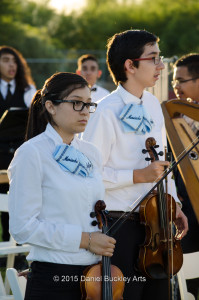 Within the group you saw something special going on. Older members were welcoming the new recruits with care and concern, joking with them as they waited for the speeches to be over, and generally making them feel not just welcome but truly part of the group. It’s how they themselves had been ushered into the group, and something that clearly explains the remarkable musical cohesion of this ensemble of players and singers. The bond starts on day one.
Within the group you saw something special going on. Older members were welcoming the new recruits with care and concern, joking with them as they waited for the speeches to be over, and generally making them feel not just welcome but truly part of the group. It’s how they themselves had been ushered into the group, and something that clearly explains the remarkable musical cohesion of this ensemble of players and singers. The bond starts on day one.
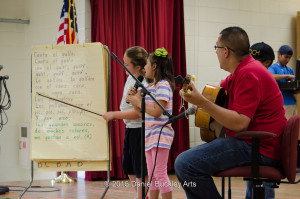 Last Wednesday I sat in on the second day of Mariachi Summer Camp at Davis Bilingual Elementary School. A school that has in many ways been the launch pad of mariachi talent throughout the entire Tucson Unified School District, for many of the young teachers and assistants in the program that afternoon, this had been the place where their love affair with the music started.
Last Wednesday I sat in on the second day of Mariachi Summer Camp at Davis Bilingual Elementary School. A school that has in many ways been the launch pad of mariachi talent throughout the entire Tucson Unified School District, for many of the young teachers and assistants in the program that afternoon, this had been the place where their love affair with the music started.
Mind you, second day. But what I saw in classroom after classroom was the same. Respect on the part of the main teachers for their young assistants, and vice versa. Respect for the students. An understood order that gets the groups of youngsters quickly and efficiently to work. And so much more.
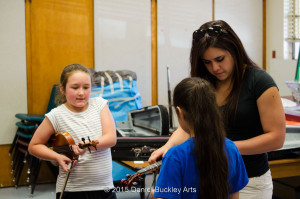 I watched University of Arizona student Adriana Dalton, who just finished her freshman year of college, working with young violin students. So easily and comfortably she worked to establish the right playing practices – how to hold the bow, how to hear and correct the wrong note, how to sit properly in the chair and how to create an ensemble sound. It was remarkable to watch, as was her interaction with her assistant, Pueblo high junior Yasmine Durazo, with whom she had played in Mariachi Aztlan until last year. There was an instant understanding of what needed to be done and how to split the student group to work collectively and individually on the music.
I watched University of Arizona student Adriana Dalton, who just finished her freshman year of college, working with young violin students. So easily and comfortably she worked to establish the right playing practices – how to hold the bow, how to hear and correct the wrong note, how to sit properly in the chair and how to create an ensemble sound. It was remarkable to watch, as was her interaction with her assistant, Pueblo high junior Yasmine Durazo, with whom she had played in Mariachi Aztlan until last year. There was an instant understanding of what needed to be done and how to split the student group to work collectively and individually on the music.
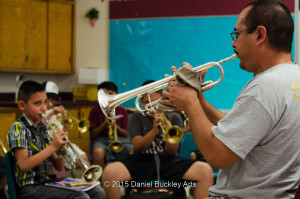 The emphasis on calm underscoring of fundamentals was in place in every room at Davis Elementary School. Rudy Valenzuela, head of the mariachi program at Roskruge Middle School, was working with trumpet players, urging them to play with their arms slightly out so as not to restrict their air flow. Guitarists were being coached to hold the instrument correctly and address elements of melody and harmony.
The emphasis on calm underscoring of fundamentals was in place in every room at Davis Elementary School. Rudy Valenzuela, head of the mariachi program at Roskruge Middle School, was working with trumpet players, urging them to play with their arms slightly out so as not to restrict their air flow. Guitarists were being coached to hold the instrument correctly and address elements of melody and harmony.
Again, I say day two, and with a group of children many of whom were barely larger than their instruments.
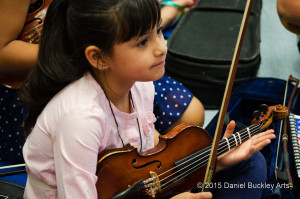 And again you see this overearching culture from the top on down, treating each other with respect, unity and purpose. Seeing this at this level, imprinting itself on the generations the way physics repeats the form of a sea shell in a galaxy light years away gives me greater understanding of the mechanics of how these youth mariachi and folklorico programs transform the societies in which they bloom.
And again you see this overearching culture from the top on down, treating each other with respect, unity and purpose. Seeing this at this level, imprinting itself on the generations the way physics repeats the form of a sea shell in a galaxy light years away gives me greater understanding of the mechanics of how these youth mariachi and folklorico programs transform the societies in which they bloom.
Click images to enlarge
My photography has more to do with America’s moon landing program than just about anything else.
As a baby boomer I watched the succession of American manned space flights, from the first sub-orbital flight of Alan Shepard, leading up to the Apollo moon landings that President Kennedy had challenged the nation to complete. I fully expected to be part of the second generation of lunar explorers who would colonize, geologically map and set up scientific instruments on the moon. But as it turned out, America’s interest in the moon was superficial and short lived.
Between 1969 and 1972, 12 men left boot prints on the lunar surface as part of the Apollo moon landing program.
It turned out to be more of a cold-war PR competition than an actual scientific effort but NASA did what it could to get some real science done in between posing with the American flag.
I was 16 when Neil Armstrong put the first footprint on the moon and 19 when Eugene Cernan left the last. But in those three years some absolutely breathtaking images came back.
As you can see from the photo above, the astronauts were equipped with fine gear. A Hasselblad camera protruded in front of them. The camera was an excellent choice both for its durability in the temperature extremes of the lunar surface, and for its ability to capture superior images, all shot by astronauts wearing space suits and gloves.
Since so much of my landscape photography has its roots in Apollo era images, particularly the mosaic-like panoramic images, I thought it might be worthwhile sharing some of my favorite images from the moon.
My favorites tend to cluster more toward the later missions when we visited epic lunar geological features, and when the rovers expanded the range of mobility of astronauts considerably.
But there are certain favorites from the early missions as well.
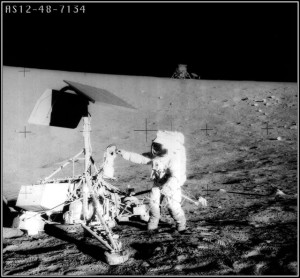 Apollo 11 was the first manned moon landing, but Apollo 12 was the first truly interesting lunar mission. It landed within a few hundred yards of the Surveyor robot spacecraft, which tested the possibility of landing on the moon a few years earlier.
Apollo 11 was the first manned moon landing, but Apollo 12 was the first truly interesting lunar mission. It landed within a few hundred yards of the Surveyor robot spacecraft, which tested the possibility of landing on the moon a few years earlier.
The astronauts snipped bits of metal and tubing from the Surveyor spacecraft and returned them to earth in order to study what the general flux of micrometeorites was, and how we could best design materials to withstand that bombardment if and when we ever colonize the moon. It also gave a pretty good indication of how the solar wind might imact spacecraft at an essential point when the International Space Station was being designed.
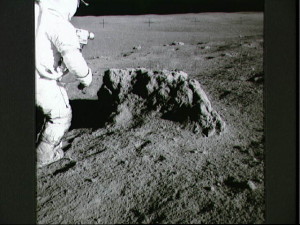 Apollo 13 suffered an explosion on its way out to the moon but managed to return the crew to the earth, thanks to some engineering wizardry on the ground. Its landing site was given to the crew of Apollo 14. Though still pretty flat land, the spacecraft touched down in the vicinity of some pretty good sized boulders.
Apollo 13 suffered an explosion on its way out to the moon but managed to return the crew to the earth, thanks to some engineering wizardry on the ground. Its landing site was given to the crew of Apollo 14. Though still pretty flat land, the spacecraft touched down in the vicinity of some pretty good sized boulders.
Apollo 15 through 17 all went to much more adventurous sites and had lunar buggies to drive around with. this expanded both the radius and the duration of the moon walks, which often stretched out to over six hours at a shot.
With Apollo 15 panoramas that show the horizon start to become more common. We see the scale of the landing area and the type of terrain visited, as well as the equipment used to travel around.
0Apollo 16 visited another more complex terrain in search of materials from the lunar highlands. At all of the sites since the beginning a variety of geophisical experiments were set up. But Apollo 16 also had a small solar observatory that it left in the shade of the rover.
The final moon mission was the first to actually land a geologist on the lunar surface. Harrison “Jack” Schmitt joined commander Eugene Cernan on what would prove to be the most ambitious EVA (Extravehicular Activity, or “moon walk”) of the Apollo era.
 Probably more than any other mission its returned images showed more of the ruggedness and variety of terrain this landing site offered, as well as how busy the astronauts were on their multiple EVAs spread over several days.
Probably more than any other mission its returned images showed more of the ruggedness and variety of terrain this landing site offered, as well as how busy the astronauts were on their multiple EVAs spread over several days.
Their panoramas show rolling hills and gigantic boulders, the gray lunar surface and the jet black sky of space.
It’s easy to understand how such other worldly images might become a source of inspiration to a photographer on earth who lives in rather rugged terrain, filled with exotic desert plants and animals.
And so these Apollo images have become a kind of touchstone in my work, both for my panoramic photography and the moon-like effects I try to bring to my gray scale imagery.
Here are a few examples of each.
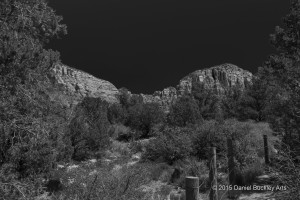 From the grayscale group here is a shot taken in Sedona, Arizona on a cloudless day of deep blue sky. In this photo the saturation of the blue sky has been reduced to zero to simulate the black sky of the moon, and also to suggest that this might have been taken at night in moonlight. In fact it was shot in broad daylight.
From the grayscale group here is a shot taken in Sedona, Arizona on a cloudless day of deep blue sky. In this photo the saturation of the blue sky has been reduced to zero to simulate the black sky of the moon, and also to suggest that this might have been taken at night in moonlight. In fact it was shot in broad daylight.
As an example of the panoramic work, here is another Sedona landscape, showing close to 180 degrees of the horizon.
 I often find myself returning to Apollo imagery for inspiration, and now find myself viewing the world around me with a very different perspective. This is becoming more pronounced as I work with models and try to achieve a very unreal sense of place as I photograph them in the desert.
I often find myself returning to Apollo imagery for inspiration, and now find myself viewing the world around me with a very different perspective. This is becoming more pronounced as I work with models and try to achieve a very unreal sense of place as I photograph them in the desert.
The first is the proverbial posing with the flag on the moon, this shot from Apollo 16.
The second is a flag waving over a junkyard in South Tucson, Arizona, presented in grayscale with the blue sky diminished to black.
 I saw it and it make me think again of the moon. One of these days I’ll take the time to mask the flag and present it full color against the black background. But for now, good enough.
I saw it and it make me think again of the moon. One of these days I’ll take the time to mask the flag and present it full color against the black background. But for now, good enough.
Click image to enlarge
The Apollo panoramas, pieced together in mosaic form from individual prints, gave me my first taste of broad terrains and the magic of large geological forms.
But the color scheme, or lack thereof, was as interesting to me as the terrain. The multiple shades of gray of the lunar surface. The stark black of the sky. These were things one doesn’t commonly see in our world.
While taking a course in digital photography we played around with using Photoshop to create and alter gray scale images.
I discovered at the time that while working in camera raw, one could easily manipulate both the saturation and luminosity of individual color areas within the image. This allows one to alter the contrast within an image, or remove a color altogether.
In photos with large parches of blue sky, turning the saturation of blue to zero turned the sky jet black when in gray scale mode. It also creates a kind of moonlit illusion when clouds are present.
But that predominantly black sky reminded me of the Apollo lunar surface images, even where both the geology and the life forms within the frame are decidedly terrestrial. And this in turn gives otherwise ordinary gray scale images an extraterrestrial quality.
Over the past few weeks I have found myself returning to old images and new with a fresh eye toward what might make either a better image in gray scale rather than color, or what might at least lend a completely different mood to a given image.
When I go out to shoot I’m also salting away some frames specifically to experiment with in gray scale mode. Just as creating panoramas made me look at the world around me with fresh eyes, so this technique is leading to a different examination of that same world.
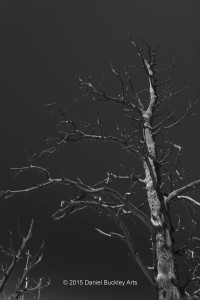 I am fiddling with sliders and curves a great deal more now than I did during our brief introduction to gray scale in the class. And I’m liking the results more as well.
I am fiddling with sliders and curves a great deal more now than I did during our brief introduction to gray scale in the class. And I’m liking the results more as well.
My world is decidedly colorful, and that’s one of the advantages of living in the southwestern U.S. But filtering that color out by wavelength, and using those filtered composites to generate new gray scale images is taking me both back in time to a black and white era, and out of place to a more moonlike southwest.
As always, one never knows where this experimentation might lead, or if it becomes a dead end.
But the journey is always what it’s about.
Yesterday I attended a concert of historic dimensions – a tribute concert to the memory of Arizona Repertory Singers’ conductor and musical director Jeffry Jahn.
Jahn died suddenly in February after spending 25 years on the podium with this group. His death was a crushing blow to the community, and especially to ARS.
Jahn was a very special man. Endowed with amazing musical and personal gifts, he had an encyclopedic knowledge, not just of the classical choral repertoire but also of opera, pop music and so much more. He had a special understanding of the human voice and knew how to bring out the best from individuals and massed voices on a sheer technical level.
But great as his technical gifts were, his humanity amplified everything he did. Quick witted and hilarious in rehearsal, he had a way of breaking tensions when they needed to be broken and explaining what he wanted in a way that never put anyone down. Moreover he not only created the sense in his singers that he cared about them personally and professionally, he in fact really did. That did so much to inspire these volunteer singers to do their very best.
Much of this I know from interviews I did recently with current and past ARS members for a tribute video I put together for this concert. But because I have been friends with several ARS members I heard these comments all the time over the years. Angela Hagen and I worked together at the Tucson Citizen for many years, and every Wednesday morning she would come in supercharged from the rehearsal the night before. “You’ve gotta see what we’re doing next,” she would insist. And it was always worth going to check out.
During my own term as a music critic with the Tucson Citizen I often covered ARS concerts and sporadically attended their rehearsals. I was always amazed at the depth and breadth of the literature the group tackled, and the prowess with which they pulled it off in concert. But when I attended those rehearsals I knew why. Jeffry Jahn was simply one of the most complete musicians I had ever seen in action, and one of the most fun to watch at work as well.
I was stunned, as was the community, on hearing that Jeffry had passed. But I had no doubt that his group would rise from the ashes, no matter how hard it would be to do so. After yesterday’s concerts members told me they couldn’t even sing in the first rehearsal after his death. The grieving was simply too overwhelming. And in the next few rehearsals after that it was truly hard going. They were foundering.
But while the holes in their hearts were large and raw, they had advantages most singers will never know. They had 25 years of the special leadership, coaching and musical knowledge of Jeffry Jahn at their backs. They ARE the vessels into which he poured that incredible knowledge. They ARE the people he nurtured and moved steadily along. They ARE the Arizona Repertory Singers.
And as yesterday’s concert proved, they still sounded like the Arizona Repertory Singers. The blend was warm and rich, the choral lines clean and well executed. The repertoire was broad and varied, and the program architecture moving and powerful. The chops were there. All was right in the world.
Jahn’s wife, interim conductor and music director Nadeen Jahn, was now on the podium and received a standing ovation as she walked into the hall from the packed house at Catalina Methodist Church. She and the singers earned another by the program’s close.
Clearly it was a very hard concert for all. But just as plainly they proved to themselves and the community that Jeffry Jahn was alive in their hearts, minds and all of the music making apparatus that they could bring to bear.
The final Alleluia by Ralph Manuel was especially touching. The singers lined the church aisles, surrounding the crowd, lending the audience a special three dimensional window into the ensemble’s remarkable sound. Soulful and heart felt, it was a moment none in the hall will forget – moving to the core, yet somehow profoundly affirmative. The Arizona Repertory Singers continue to fall back on their special training. And doing so will ensure not just their survival but their rebirth as one of Tucson’s most potent musical forces.
Click image to enlarge
Early in 2015 I started a new branch of my Bewilderness photo series.
Previously Bewilderness had been a collaborative series shooting models doing something or wearing something entirely out of place to the “wilderness” setting in which they appeared. These included such things as roller derby girls on train wrecks and nudes in the thorny, inhspitable desert.
That initial series typically resulted in large panoramic images that raised about equal visual interest in the landscape and the peculiar action of the model within that landscape.
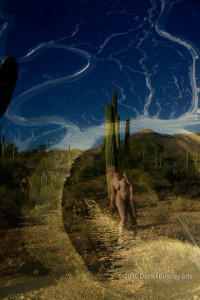 But just after the beginning of 2015 I began a new experimental phase of mainly standard frame size images. Inspired by my musical compositions and an experimental film collarboration with performance artist Laura Milkins, these new images combined two or more photographs into a single image, and in essence using each semi-transparent image as a filter for the rest.
But just after the beginning of 2015 I began a new experimental phase of mainly standard frame size images. Inspired by my musical compositions and an experimental film collarboration with performance artist Laura Milkins, these new images combined two or more photographs into a single image, and in essence using each semi-transparent image as a filter for the rest.
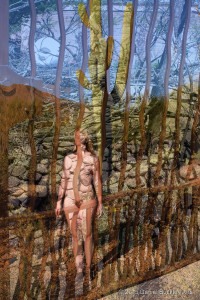 The series has been evolving steadily. At first the images were mainly textural studies. But of late the process has inpired some new surreal combinations.
The series has been evolving steadily. At first the images were mainly textural studies. But of late the process has inpired some new surreal combinations.
In these recent studies I have used as the base material some nudes with model Laura Milkins shot in the desert a few years back, and we are about to embrak on some new sessions to add to that source material.
The nude is ideal to work with, both because the eye recognizes it instictively and because the skin becomes a canvas upon which the other layered images project. Moreover the curves and lines of the human form can be imitated, obscured and amlified in the layering process. And the combinations of images are often startling.
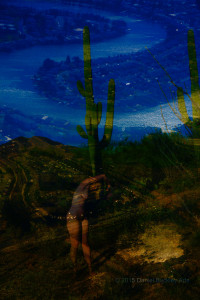 The drama of the pose as well finds new narrative when combined with other images elements.
The drama of the pose as well finds new narrative when combined with other images elements.
As someone whose photography has mainly been representational of landscapes, cityscapes, people and the sky, this experimental branch is again changing how I view the world around me.
It is suggesting new photographic studies, and sending me back to my Adobe Lightroom catalog of images to find new material to experiemnt with.
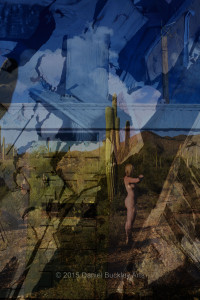 I expect that in the next few months this series will take on even more unexpected spins.
I expect that in the next few months this series will take on even more unexpected spins.
Click images to enlarge
As I write my artist statement for my submission to the Arizona Biennial show at the Tucson Museum of Art later this year, I find myself again contemplating how frequently ideas that impact my work in all media have their conceptual genesis in an entirely different artform.
Everything we do as artists filters into our art. Our loves and losses, human triumphs and tragedies, our friendships, associations and experiences, but also our work on all fronts.
More and more I think of myself as a digital artist – a composer, writer, photographer, performance artist and filmmaker who uses digital technology in all I do.
I typically work multiple projects in several disciplines simultaneously, and let discoveries in each open new paths for the rest. This has become particularly plain in a new offshoot of one of my photographic series.
In 2014 I started a photographic series called Bewilderness. The original concept was a series of collaborative projects with models in which peculiar goings-on would be photographed to create curious panoramic images in various incongruous landscapes. Recently a new branch sprouted to the series involving standard-frame size images merging landscapes, textures and human forms into something akin to visual poetry.
This latest branch of composite image making takes all of its cues from processes first explored as a composer of electronic music. Filtering, blending and mixing constructs are the foundations of my musical pursuits. These in time became the genesis of experimental techniques explored in a film I have been working on for the past two years in collaboration with performance artist Laura Milkins. Titled “Poem From Memory,” it employs several simultaneous layers of time-lapse and slowed down video, as well as slow moving animation, to create the illusion of movement through impossible, surreal landscapes. That exploration of image layering in turn gave rise to a new branch of the Bewilderness series. And again, this is leading to refinements of the musical score for the film, based on discoveries made in both the film and still images.
I have always found that simultaneously working multiple projects leads to both inspirational and technical breakthroughs for all. Techniques developed in commercial projects I am involved in find their way into my artistic endeavors, and vice versa. Curiously the simultaneous work lessens the stress associated with each rather than compounding it. Being able to step away from a film project, for example, to compose just for the hell of it, or to step out into the desert to reimagine my world, allows me to return to the main project with fresh eyes and ears.